The Google Nexus 9 Review
by Joshua Ho & Ryan Smith on February 4, 2015 8:00 AM EST- Posted in
- Tablets
- HTC
- Project Denver
- Android
- Mobile
- NVIDIA
- Nexus 9
- Lollipop
- Android 5.0
Battery Life
It goes without saying that battery life is one of the most important aspects of a mobile device. After all, a mobile device isn’t really mobile if it can only be used for an hour before running out of battery. In order to test this, we turn to our standard suite of battery life tests, which include our web browser battery life test, along with some compute-bound benchmarks to characterize battery life across various use cases.
However, as the Nexus 9 introduces such a unique CPU architecture, I felt that it was necessary to try and adequately capture the full extent of battery life. To this end, I’ve introduced a new test that is really quite simple but important, as we can start to separate display power from everything else since it can often be the single largest consumer of power in a test. In order to do this, everything that could run during a test is disabled, and the device is placed in airplane mode with the display at 200 nits. A white image is displayed on the screen from a full charge until the device shuts down.
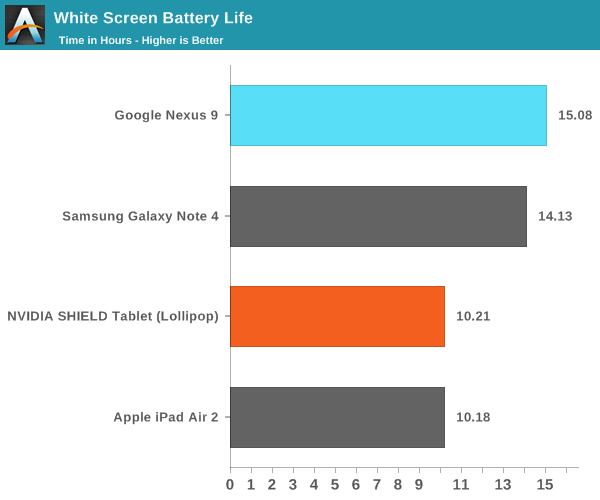
Interestingly enough, the display runtime on the Nexus 9 is about as good as it gets when compared to other devices for which we have data. I suspect we’re looking at the direct result of the large battery combined with an efficient display, as the Nexus 9 can last as long as 15 hours in this test compared to the iPad Air 2’s 10 hours.
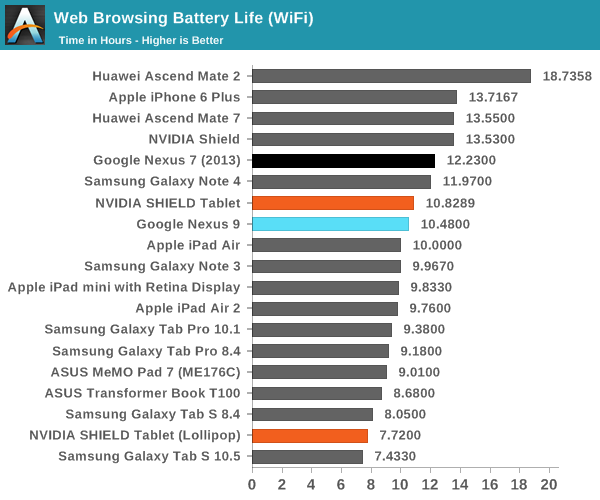
Unfortunately, the massive lead that we saw with the pure display test is significantly eroded in our web browser test. Our web test is primarily focused upon CPU, connectivity, and display efficiency. Seeing as how the Nexus 9’s display is far ahead of the iPad Air 2 and connectivity should be broadly similar in power efficiency, it seems that all of the efficiency gains from the display have gone into powering the Denver CPUs. It’s likely that process has a significant effect on this, so the more valid comparison is between SHIELD Tablet and the Nexus 9. At any rate, the Nexus 9 does manage to deliver solid battery life performance in this test which is definitely a good thing.
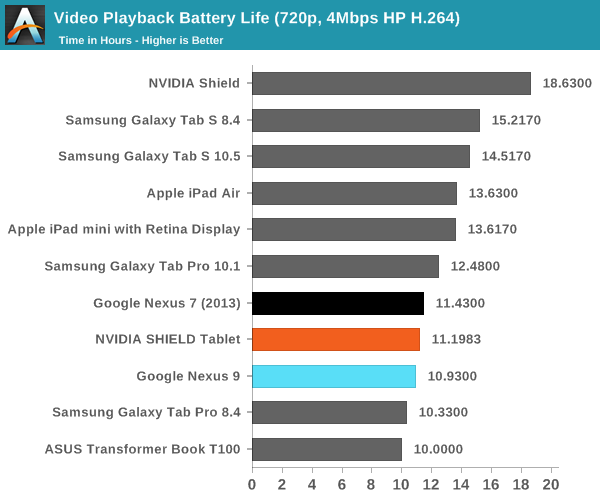
When we move to our pure video test, the Nexus 9 does have a minor regression when compared to the Nexus 7 (2013) and SHIELD Tablet. In this case, the AMOLED displays on the Galaxy Tab S line make for an easy victory due to the relatively high amount of black displayed in the content. The gap is closed between the two devices though, due to a reduced focus on SoC power.
While our web browsing test can give some idea of efficiency, there are often cases where more compute is directly used to support a better experience. To try and test for these compute-bound cases, we use Basemark OS II’s CPU battery life test and GFXBench’s T-Rex rundown for a GPU battery life test. As with the web browsing tests, these are run at 200 nits to keep things relatively equal.
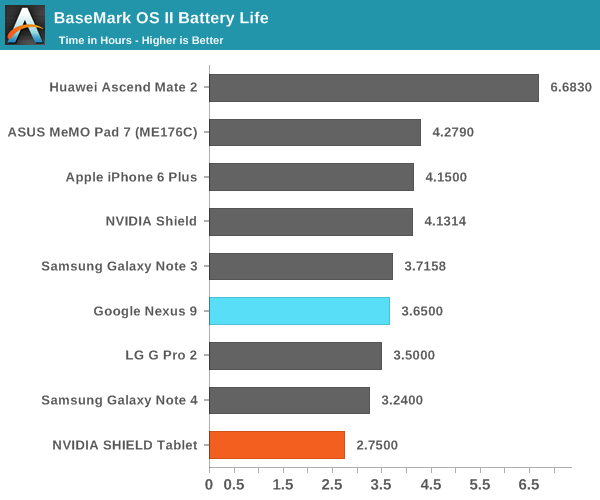

In Basemark OS II, the Nexus 9 does a surprisingly good job as the CPU manages to keep incredibly high sustained performance. The large battery and efficient display seem to help to a significant extent.
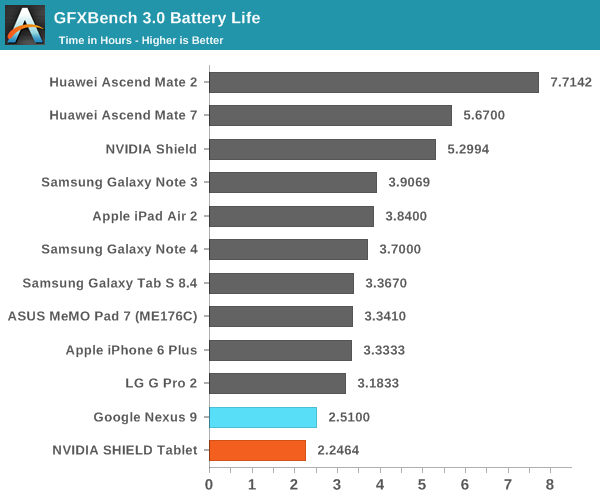

In GFXBench, it seems that not much changes overall. The GPU is definitely more power hungry than the PowerVR Series 6XT line-up and sustained performance is noticeably worse, but it’s in line with the SHIELD Tablet. End of run performance ends up a bit lower, but higher than one might expect. This is likely due to differing ambient temperatures. In practice, skin temperatures are about 45C in this test and localized to the top half of the device, and it’s likely that internal temperatures are around 80C as well. Seeing as how Tegra K1 can theoretically draw 33W in platforms such as the Jetson TK1 dev board with active cooling, it's incredibly impressive to see NVIDIA effectively keep such a powerful SoC within the constraints of a passively-cooled tablet.
Charge Time
While battery life is one part of the equation, charge time is an equally important aspect of overall battery life. To measure this, we measure the time from when charging begins to when the device reaches 100% charge. This is confirmed by taking measurements at the power outlet to make sure that power draw is below a certain level.
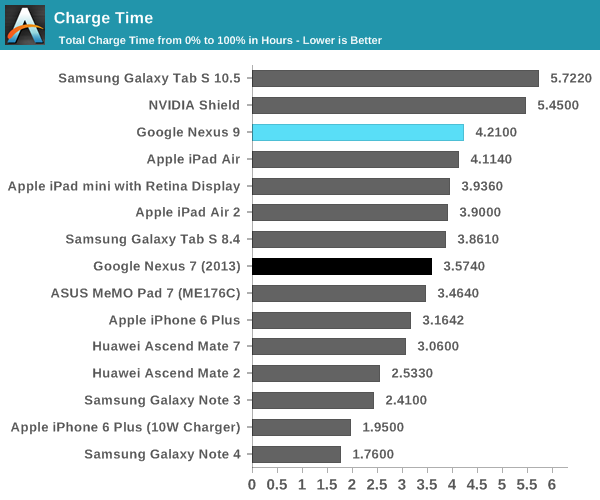
In this regard, the Nexus 9 is merely average for a tablet, although it does fall behind the competition as it uses a 5V, 1.5A charger for 7.5W instead of the 12-15W chargers that we’ve seen recently. It shouldn’t be a big issue, but in general this does mean that devices like the Galaxy Note 4 are actually better at battery life overall when compared to most tablets.










169 Comments
View All Comments
Mondozai - Wednesday, February 4, 2015 - link
No offence but how relevant is this review so many months after release?You guys dropped the ball on this one. We're also still waiting for the GTX 960 review.
What has happened to Anandtech...
LocutusEstBorg - Wednesday, February 4, 2015 - link
There's no Anand.nathanddrews - Wednesday, February 4, 2015 - link
That's the only change I've noticed.Morawka - Wednesday, February 4, 2015 - link
and no Brian Klugnathanddrews - Wednesday, February 4, 2015 - link
Yeah, but that was earlier.Ryan Smith - Wednesday, February 4, 2015 - link
"What has happened to Anandtech..."Nothing has happened to AnandTech. We're still here and working away at new articles.=)
However this article fell victim to bad timing. The short story is that I was out sick for almost 2 weeks in December, which meant this got backed up into the mess that is the holidays and CES.
As for how relevant it is, it is still Google's premiere large format tablet and the only shipping Denver device, both of which make it a very interesting product.
Jon Tseng - Wednesday, February 4, 2015 - link
It's fine to be late (although maybe not as late as the Razer Blade 2014 review!). Better to have late, differentiated content than early, commoditised content. Whether the review like's the colour of a tablet's trim is of limited interest for me; the details of Denver code-morphing are.Actually my worry is that under new ownership Anandtech might be pushed to go down the publish early/get click views route vs. the publish late/actually deliver something useful. Hopefully it won't come to this, but this is what historically happens... :-(
Operandi - Thursday, February 5, 2015 - link
Being there on day one is not a huge deal but its certainly not ok be as late as this review is or the still MIA 960 review. If you are going to be late you better be brining something new to the table to justify not being there in the same time frame as your peers. This is so laughably late its almost embarrassing to release it at all at this point.Tech journalism like most other markets is competitive and there are lots of other very competent publications out there competing for the same readers. Personally I've already gotten all the Nexus 9 information elsewhere so this review is of no value to me whatsoever. The same goes for the 960 review when/if that review ever shows up.
akdj - Wednesday, February 11, 2015 - link
Not sure where you've seen such an extensive write up and dissection of Denver, but I certainky haven't. Nor were the N9/6 widely available until the holidays were over. Like a month agoFor every 10,000,000 iPads produced, HTC is probably knocking out 10,000
Excellent review, write up and information about the 'other 64bit' option.
Taneli - Wednesday, February 4, 2015 - link
Timing is secondary for a deeply technical article like this here. You guys did exactly the right thing, reporting when the device was announced and waited for the review to be done before publishing. Also, having people out sick in a small team is something you really can't do that much about. I hope you're well now.The article itself was superb. Thanks for the read and keep up the good work.